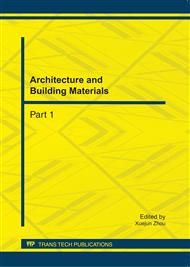p.1203
p.1209
p.1214
p.1218
p.1222
p.1228
p.1233
p.1239
p.1243
Effect of Admixture on the Frost Resistance of Steam-Curing Concrete
Abstract:
The effects of polycarboxylate superplasticizers, naphthalene-based superplasticizers and SJ-2 air-entraining agent on the frost resistance of C50 concrete under steam-curing were studied by a rapid freezing-thawing method.The frost resistances of concrete under three different temperature condition curing are compared. The results show that the polycarboxylate superplasticizer concrete is more suitable to steam curing and has better frost resistance than naphthalene-based, especially under a low temperature steam-curing condition. When the SJ-2 air-entraining agent was added to polycarboxylate superplasticizer concrete, the frost resistance of concrete has been further improved. When the steam curing temperature is too high, the frost resistance of concrete with admixture is not improved.
Info:
Periodical:
Pages:
1222-1227
Citation:
Online since:
September 2011
Authors:
Price:
Сopyright:
© 2011 Trans Tech Publications Ltd. All Rights Reserved
Share:
Citation:


